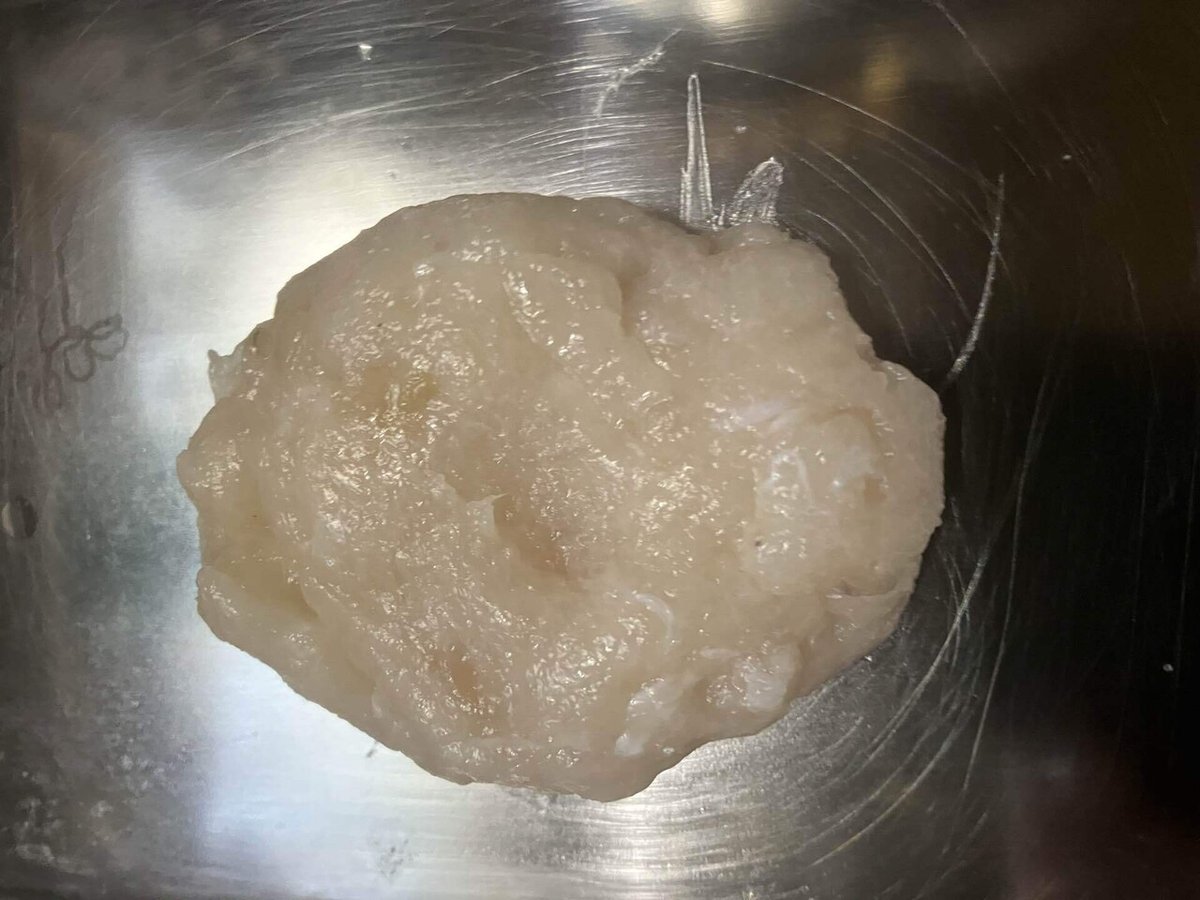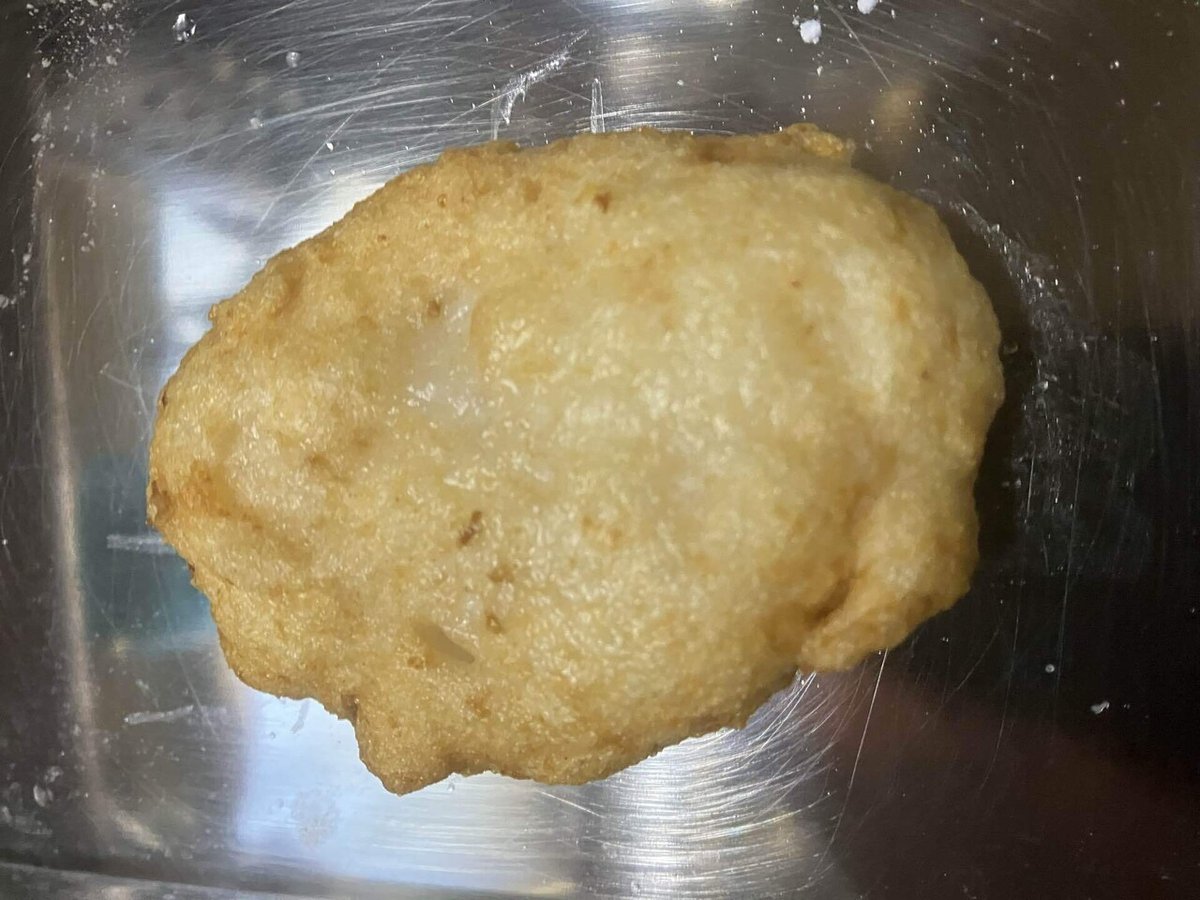
おでんのための練り物専科(さつま揚げ)Fish paste speciality for oden (Satsumaage)
おでん屋のレシピ集
Oden restaurant recipe collection
ストーリー
Recipe trivia
最高のおでんを作るためのこだわりはどこだろうか?まずは「出汁」。これは前にレシピを紹介した。ではその次は?それは間違いなく練り物だ。
何故かというと、おでんという素材はおでんのタネの中で最大のブラックボックスだからだ。大根などの野菜は誤魔化しようがない。野菜自体が不味いか美味いかだ。齧ってみればわかる。豆腐加工品も同様だ。基本的に豆腐を揚げているだけだからだ。不味い豆腐で作ったか美味い豆腐で作ったか、新鮮な油で揚げてあるかだ。どちらかというと受け身の食材で、出汁が美味ければ、その美味い出汁を吸収して美味しくなる。だから良いものを買って美味い出汁が作ってあれば不味いわけがない。問題は「練り物」だ。旨みの塊である魚で作られている。含まれているアミノ酸が溶け出して、豆腐のように受け身ではなく、おでん出汁に能動的に変容を与える。せっかく気合を入れて丁寧に取った出汁が、さらに上手くなるか台無しになるかは、練り物にかかっている。
What is the key to making the best oden? First, the "dashi" (soup stock). I've already introduced the recipe for this. So what's next? It's definitely the fish paste.
The reason is that the ingredients of oden are the biggest black box of oden ingredients. There's no way to hide vegetables such as radishes. The vegetables themselves are either bad or good. You can tell by biting into them. The same goes for processed tofu. Because it's basically just fried tofu. It's either made with bad tofu or good tofu, and fried in fresh oil. It's a more passive ingredient, and if the dashi is good, it will absorb the delicious dashi and become delicious. So if you buy good ingredients and make a delicious dashi, it can't be bad. The problem is the "fish paste". It's made from fish, which is a lump of umami. The amino acids contained in it dissolve and actively transform the oden dashi, not passively like tofu. Whether the soup stock that was so carefully and painstakingly made will taste even better or be ruined depends on the fish paste.
高級な練り物を買ったら良いではないかと思うかもしれない。実はそうは簡単な話ではない。練り物の場合、一般的に高級という意味は、良い魚のすり身を使っているという意味だからだ。高級でもかなりの添加物が入っている。特に砂糖と化学系うま味調味料の添加は、高級な練り物でも普通に行われている。添加物の良し悪しにはここでは触れない。ただ、僕には、技術者として、出汁の味がどう転ぶか分からないブラックボックスである点が気持ち悪いのだ。だから、おでんを極めたいなら練り物も自家製したいという結論に辿り着く。もちろん世の中には良心的なおでんタネ屋さんが何軒も存在していて、購入可能な範囲に住んでいるなら、自家製の必要はないだろう。残念ながら、予算的にも距離的にも僕の周りにはそういうお店が無いので、自作しているというわけだ。厳密に言えば予算を無視するなら僕の街にも良い練り物屋さんがある。ただ、屋台で出してあげられるようなおでんにはならない。京都や北新地の締めに使う高級おでん割烹の値段になってしまう。
You might think it would be better to just buy high-quality fish paste. In fact, it's not that simple. In the case of fish paste, high-quality generally means that it uses high-quality fish paste. Even high-quality fish paste contains a lot of additives. In particular, the addition of sugar and chemical umami seasonings is common even in high-quality fish paste. I won't go into the pros and cons of additives here. However, as an engineer, I feel uncomfortable with the black box of not knowing how the flavor of the soup stock will turn out. That's why I've come to the conclusion that if I want to master oden, I want to make my own fish paste. Of course, there are many conscientious fish paste shops that sell additive-free fish paste, and if you live within a reasonable distance, there's no need to make it yourself. Unfortunately, there are no such shops around me, both in terms of budget and distance, so I make it myself. Strictly speaking, if you ignore the budget, there are good fish paste shops in my town. However, it doesn't make the kind of oden that you can serve at a food stall. It costs the same as a high-end oden meal served at a traditional Japanese restaurant in Kyoto or Kitashinchi, which would be the perfect final meal after a night of drinking.
練り物といえば、つみれやはんぺんもあるけれど、まずはさつま揚げを取り上げよう。材料が食感にどう反映するかを見るために、いきなり全ての材料を混ぜずに、段階的に加えてみよう。
「さつま揚げ」は「琉球揚げ」とも呼ばれていて、どうやら南方から日本に伝わってきたらしい。同じカテゴリーの揚げ物は東南アジアにも存在する。冷蔵庫のない時代に、暑い国で大量に採れた魚をすり身にして高温の油で揚げるのは優れた工夫だ。揚げ物をあまりしなかった当時の日本では、琉球を通って南方から伝わってきたハイカラな調理法だったようだ。江戸後期から明治にかけて徐々に普及し、おでんにはなくてはならない素材になった。
Speaking of fish paste, there are tsumire(dark fish balls) and hanpen (soft fish cakes), but let's start with satsumaage (fried fish cakes). In order to see how the ingredients affect the texture, try adding them in stages, rather than mixing all the ingredients at once.
"Satsuma(Kagoshima)-age" is also known as "Ryukyu(Okinawa)-age" and appears to have been introduced to Japan from the south. The same category of fried foods exists in Southeast Asia. In an era before refrigerators, in hot countries, the method of mincing the fish caught in large quantities and frying them in high-temperature oil was an excellent innovation. In Japan at the time, where deep-frying was not common, it seems to have been a sophisticated cooking method that was introduced from the south via Ryukyu. It gradually became popular from the late Edo period through the Meiji period, and became an essential ingredient in oden.
Ingredients:
材料:
魚※
自然塩
黒糖
片栗粉
長芋
揚げ油
※ここでは、安価に流通しているパンガシウス(ナマズ目)とモウカサメ(ネズミザメ)を使ったが、どんな魚でも良い。
Fish※
Natural salt
Brown sugar
Potato starch
Yam
Oil that is resistant to oxidation
*Here, I used Pangasius (a catfish) and Scutellaria (a salmon shark), which are inexpensive and readily available, but you can use any fish.
procedure:
手順:
この料理は基本的には魚と塩があれば成立する。後の材料はオプションだ。
This dish basically requires only fish and salt, the rest of the ingredients are optional.
魚は骨と内臓を取り除き、小骨を抜いて、皮も引いておく。もちろん切り身を使っても構わない。その場合は、小骨だけ残らないように抜けば良い。ミンチにし易いように小さくカットしておく。
2種類の魚を用意したのは食感や色めの違いを実験するためだ。
昔はすり鉢ですり潰していたが、今は安価にフードプロセッサーが買えるので、それを使うと楽だ。
Remove the bones and innards from the fish, remove any small bones, and also the skin. You can of course use fillets as well. In that case, just make sure to remove all the small bones. Cut the fish into small pieces so that it's easier to mince.
I prepared two types of fish so that I could experiment with differences in texture and color.
In the past, I would mash the fish in a mortar and pestle, but nowadays you can buy a food processor cheaply, so it's easier to use that.
では、最初は、塩だけ入れた魚のすり身で試してみよう。
すり身ができたら、手に油をつけて小判形に整形し、摂氏160度に熱した油で、油の温度が下がらないように注意しながら、ゆっくり時間をかけて揚げる。揚げると膨れるので平べったく整形すると良い。天ぷらなどよりも油の温度は低めでそこそこ時間がかかるので、慌てないでゆっくり火を通すと良い。この温度だと焦げることはない。
So, first let's try it with fish paste that has only been seasoned with salt.
Once the paste is ready, put oil on your hands and shape it into an oval shape, then fry it slowly over time in oil heated to 160 degrees Celsius, being careful not to let the temperature of the oil drop. It will expand when deep-frying, so it's best to shape it into a flat shape. The oil temperature is lower than for tempura, and it takes quite a while to cook, so take your time and cook it slowly. At this temperature it won't burn.






綺麗な切り口だ。魚の旨味がいっぱいの普通の美味しいさつま揚げになった。ただ市販品とは違った味わいだ。甘味が足りないのだ。
次は、塩と同量の黒糖を入れて、さらにミンチをかき混ぜてから、同じ手順で揚げる。
The cut is beautiful. It's a delicious fish cake filled with the flavor of the fish. However, it tastes different from store-bought ones. It's not sweet enough.
Next, add the same amount of brown sugar as the salt, mix in the minced meat, and fry again using the same procedure.
市販のさつま揚げとほとんど変わらない。個人的には、妙な甘みとケミカルな旨味がないだけ、口に嫌な後味が残らず、市販品より美味いと思う。味としてはこれで完結している。
次は、食感の違いを見るために、1割程度の片栗粉を混ぜてみた。
It's almost the same as commercially available satsumaage. Personally, I think it's better than the commercial ones, except that it doesn't have the strange sweetness or chemical umami, and I don't feel any unpleasant aftertaste in my mouth. In terms of flavor, it's complete.
Next, I tried mixing in about 10% potato starch to see the difference in texture.
片栗粉を加えると、よりしっかりした食感を感じる。人によってはこちらの方が好みかもしれない。食感はこちらの方が市販品に近い。
試しに、割合を2割に増やすと、食感はより固くなった。これは明らかに味が薄まって混ぜ物を感じ、硬すぎるとも感じた。
次は、長芋を添加してみた。

Adding potato starch gives it a firmer texture. Some people may prefer this. The texture is closer to that of commercially available products.
As an experiment, I increased the ratio to 20% and the texture became harder. This clearly diluted the flavor, tasted like it had been mixed in, and felt too hard.
Next, I tried adding yam.
これは、なんともいえないふわふわな食感が出る。たくさん入れれば、はんぺんのような柔らかい食感も出せそうだ。片栗粉や山芋は必須ではないけれど、上手に組み合わせて添加すれば、とても美味しいさつま揚げに仕上がると思った。ただ、沢山入れると、さつま揚げというよりははんぺんの食感にに近づいて行く。さつま揚げと呼ぶなら、一割くらいの添加が適切に思えた。


This gives it an indescribable fluffy texture. If you add a lot, it seems like it can also have a soft texture like hanpen. Potato starch and mountain yam are not essential, but if you add them in the right combination, I think it will result in a very delicious satsumaage. However, if you add a lot, it will have a texture closer to hanpen than satsumaage. If you want to call it satsumaage, I think adding about 10% of it is appropriate.
次は、すり身自体を鯰ではなくサメに取り替えて試してみた。鯰は雑味のない白身の魚だけど、鮫は、マグロほどではないにせよ、身に血が少し混じっている。日本人は白身と赤身の中間という意味で「青身」と呼ぶ。鰯や鯖もこのグループに属する。鮫は鰯より白身に近い青身だ。





Next, I tried replacing the paste with shark instead of catfish. Catfish is a clean white fish, but shark has a little blood in it, although not as much as tuna. Japanese people call it "blue meat" because it is somewhere between white and red meat. Sardines and mackerel also belong to this group. Shark has blue meat that is closer to white meat than sardines.
まず、切り口は白い鯰と違って灰色がかっている。味も、上品な鯰の身に比べると、大分野趣味がある。これはこれで別の美味しさだ。ただ、どちらかというとつみれの食感と食味に近い。別カテゴリーと考えて、後日、別の機会にもう少し深堀してみたい。
First of all, the cut surface is grayish, unlike the white catfish. The taste of the shark meat is also more rustic than the elegant catfish meat. This is a different kind of deliciousness. However, the texture and taste are more similar to that of fish balls. I would like to consider it a different category and delve deeper into it at a later date.
もちろん、どちらも、そのまま食べても最高だけど、おでん出汁で煮込めば、究極の素材として大活躍する。
Of course, both are great when eaten as is, but when simmered in oden broth, they become the ultimate ingredients.
最後に、鯰をベースにした白身のすり身に、牛蒡、人参、干し椎茸を細く刻んで混ぜた。自画自賛だけど、それは市販品を超える完全なさつま揚げになったと自己満足できる仕上がりだった。
Finally, I mixed finely chopped burdock, carrots, and rehydrated dried shiitake mushrooms into a catfish-based white fish paste. I'm a little proud of myself, but I was pleased with the result, as I felt it was a perfect satsumaage that surpassed commercially available products.




Tips and tricks:
コツと応用のヒント:
さつま揚げに最適な魚は、ここで使ったパンガシウスの他、鱈、鯛、カレイ、メルルーサ、赤魚などが挙げられる。切り口が白く繊細な味のさつま揚げが出来上がる。漁師風の野趣味を出したいなら、青身の魚を混ぜると良い。ここで試した鮫のほか、飛魚、鰺、鯖、鰯などが良いだろう。
鮪や鰹も使えるが、さつま揚げと呼ぶのはちょっと難しい。青身や赤身を使うおでんの材料は、違った名前で呼ばれるので、後日改めて扱ってみたい。日本では鮭や鱒はおでんの材料には取り上げられなかった。そこはまだ研究の価値があるのではないかと思う。
その他、おでんの練り物として、ここで扱った白身の練り物に、副材料として、烏賊、蛸、蟹貝類、海藻、卵を加えるバリエーションが存在する。その辺りにも、また触れる機会があると思う。
In addition to the pangasius used here, other fish that are best for satsumaage include cod, sea bream, flounder, hake, monkfish, and red fish. The resulting satsumaage has a white cut surface and a delicate flavor. If you want to create a rustic fisherman-like taste, it's a good idea to mix in some blue-fleshed fish. In addition to the shark used here, flying fish, horse mackerel, mackerel, and sardines are good choices.
You can also use tuna and bonito, but it's a bit difficult to call them satsumaage. Ingredients for oden that use blue or red meat are called by different names, so I would like to cover them again at a later date. In Japan, salmon and trout have not been mentioned as ingredients for oden. I think that this is still worth researching.
There are also variations of oden paste that add squid, octopus, crab shellfish, seaweed, and eggs as secondary ingredients to the white-fleshed paste used here. I think I will have an opportunity to touch on that again.
ここでも検証できたが、市販のさつま揚げにはかなりの量の砂糖が入っている。だから、おでん出汁を作るときは砂糖や味醂などの甘味料は入れない方が良い。添加されている甘味料で十分だからだ。
ここではグルテンフリーにするために片栗粉を使っているが、米粉や小麦粉など、他の澱粉でも構わない。それぞれ微妙に食感が違うので、単独あるいは複数混ぜて使ってみても面白いと思う。
山芋の他に卵を使うレシピもあるが、それはまた別の機会に扱う。
おでんに使わずとも、釣果など、魚が纏まって手に入った時にさつま揚げを作っておくと重宝する。一週間は冷蔵庫で日持ちするので、お弁当に入れたり、煮物に材料にしたり、軽く焼いてお酒のおつまみにしたり、応用範囲は広い。ワインとのマリアージュも最高だ。
As we verified here, commercially available satsumaage contains a considerable amount of sugar. Therefore, when making oden broth, it is better not to add sweeteners such as sugar or mirin. The sweeteners added are sufficient.
Here, we use potato starch to make it gluten-free, but other starches such as rice flour or wheat flour can also be used. Each has a slightly different texture, so it would be interesting to try using them alone or in combination.
There are recipes that use eggs in addition to mountain yam, but we will cover that on another occasion.
Even if you don't use it in oden, it is useful to make satsumaage when you get a lot of fish, such as after a catch. It will last in the refrigerator for a week, so it can be used in a wide range of applications, such as putting it in a lunch box, using it as an ingredient in a stew, or lightly grilling it to eat with alcohol. It also pairs great with wine. If you store it in the chilled compartment or freezer, you can enjoy it for more than a month.
Guide to where to get ingredients and equipment 材料と機材の入手先ガイド
この記事が気に入ったらサポートをしてみませんか?
